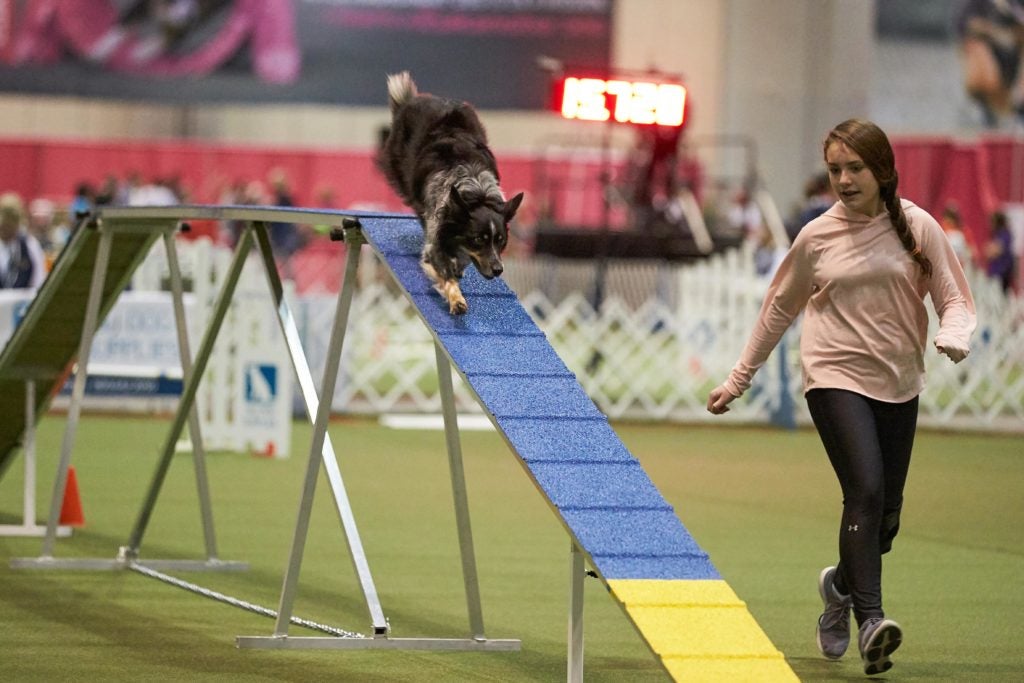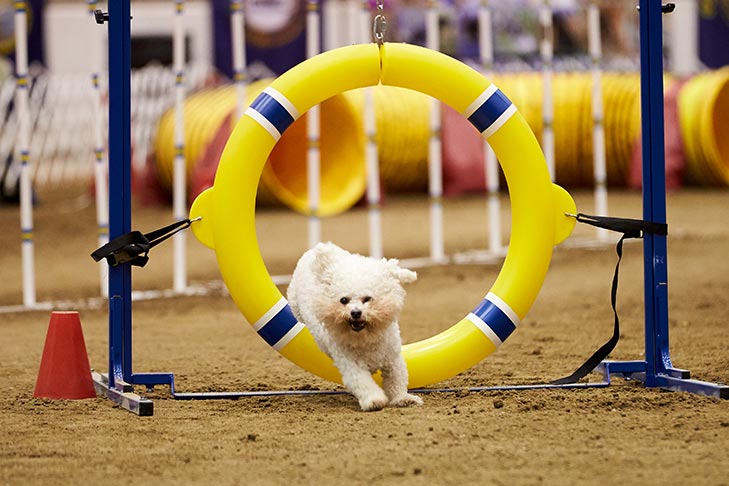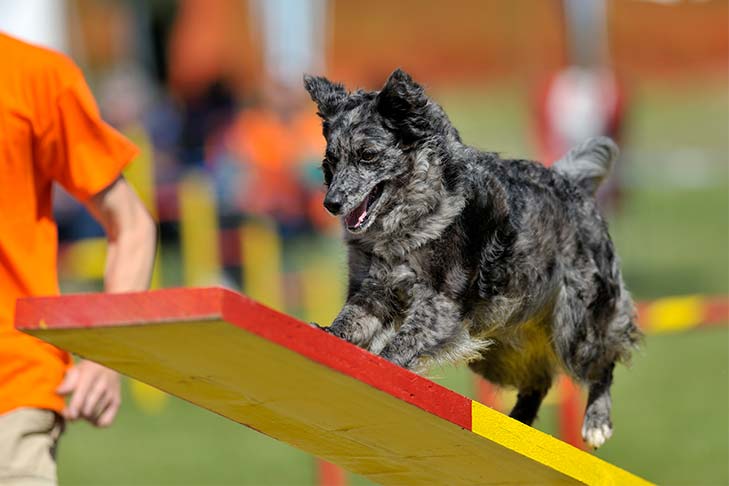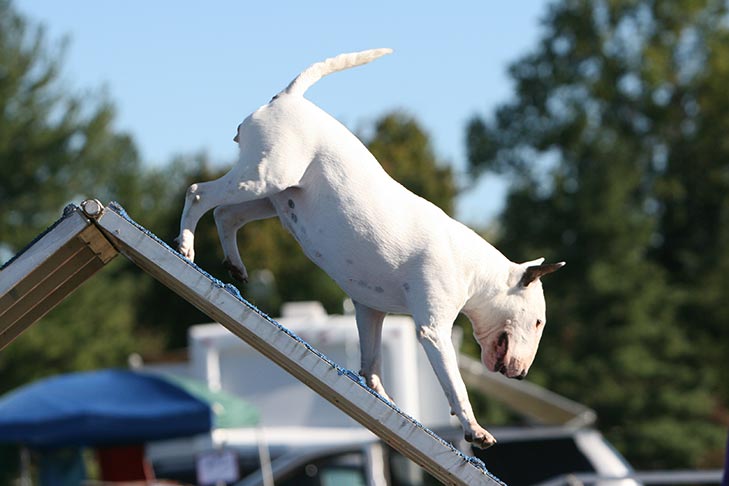From March 16 through 19 in Tulsa, Oklahoma, top canine competitors from across the country will gather for the 2023 National Agility Championship at the Built Ford Tough Livestock Complex at Expo Square. Many people may not be familiar with Agility competitions, where dogs navigate through an obstacle course while racing against the clock. Even for those who have heard of the sport, acting as a simple spectator can be a little intimidating.
We are here to fill you in on the basics of watching an agility event — including a breakdown of each obstacle and how scoring works. Who knows? You may just be inspired to start training your pup after this mini-introduction.
Agility Course Obstacles
Courses typically have between 14-20 obstacles. Here are several types of agility obstacles you’ll run into:
1. Jumps — These vary from course to course, but a dog must leap over the bar without displacing it. The height of the dog determines the height of each jump. FYI: Dogs are measured before the competition.

2. Dog Walk — A dog must run up the ramp on one side, scamper across the top horizontal plank, then run down the ramp on the other side, being sure to touch the “contact zone” (usually painted a bright yellow) at the bottom of the board as they exit.

3. Weave Poles — Weave poles consist of six to 12 upright poles. A dog must enter to the right of the first one and weave through each of the others quickly: without missing a pole. It is considered one of the trickiest obstacles to master.

4. Tire Jump — A dog must jump quickly and cleanly through the opening of the tire. The height of the jump is based on the height of the dog.

5. Open Tunnel — The objective is simple: A dog must enter from one side and exit through the other. Although the tunnel is often curved so the dog can’t see the exit from the entrance, given how straightforward it is, the Open Tunnel is often considered a great place to start when training.

6. Seesaw — Unlike the seesaws you may have played on as a child, dogs don’t get a partner for this obstacle. After running up the board and down the other side as it pivots with their momentum, a dog must touch the “contact zone” with at least one toenail as they descend.

7. A-frame — An A-frame consists of two broad ramps hinged together. A dog must quickly scale the structure, scramble over the apex, and touch the “contact zone” while descending.

8. Pause Table — This obstacle slows the team’s forward momentum. A dog must pause on the table for five consecutive seconds.

An Intro to Dog Agility Scoring
To earn a qualifying score, a dog must complete the course with the minimum defined standards for time, faults, and points and without receiving any non-qualifying deductions. Wondering how a dog gets judged on each obstacle? Carrie DeYoung, AKC’s Director of Agility, walks us through the process.
1. What Is a Fault, and How Is it Calculated?
Many actions can result in a fault, including entering the weave poles incorrectly or missing a pole altogether, failing to place a foot in the “contact zone” while performing an obstacle like the seesaw, or performing the obstacles out of order.
“There are many different faults, which result in five faults to a disqualification,” DeYoung explains. “For example, if [a dog] knocks down a bar on a Jump, it is a ‘Failure,’ and they get a ‘0’ score [for that obstacle]. In Novice or Open Standard and Jumpers With Weaves courses, if a dog gets a Refusal (R) — meaning he turned away from or stopped in front of the obstacle — he can still qualify since it is just five points off, but in Excellent and Masters [courses] a dog has to have perfect runs.”
2. How Does Scoring Differ Based on Class?
There are many classes and levels — which include Novice, Regular, Jumpers With Weaves, and Master, to name a few — so it would be difficult to list all the differences here. A dog competing in the Master Class, which provides “an opportunity for dogs and handlers to demonstrate their superior skills in agility,” according to AKC’s regulations for agility trials, has higher expectations than a dog competing in the Standard class, for example. As DeYoung shares, a Master Class dog must receive a score of 100 to qualify and has more obstacles to complete. A Novice or Standard dog has more room for error.
3. How Are Course Times Determined?
“In Standard and Jumpers With Weaves, the courses are measured by the judges [with a measuring wheel],” DeYoung says. “In Time 2 Beat, FAST, and Premier classes, there is a set time in the regulations. The jump height ultimately determines times in all classes.”
4. What Happens if a Dog Goes Over Time?
DeYoung explains, “At a Regular trial, they lose points based on the level they are competing at. At the Master level, they must always be under time to qualify. At Nationals, for each second over they receive a three-point penalty.”
5. What Are the Different Height Categories?
“The different jump heights are determined by the dog’s height at the shoulder,” DeYoung shares. The following jump height divisions are used in all trial Regular classes:
- 8 inches (for dogs 11 inches and under at the withers — the ridge between the shoulder blades of a dog)
- 12 inches (for dogs 14 inches and under at the withers)
- 16 inches (for dogs 18 inches and under at the withers)
- 20 inches (for dogs 22 inches and under at the withers)
- 24 inches (for dogs over 22 inches at the withers)
Get Started in Agility
As with any sport, we recommend you start in Agility by taking a class at an AKC club near you. Practicing at home is just as important. To do so, you’ll want to set up your own obstacles. Ready to compete or watch more? Find an agility event near you.

